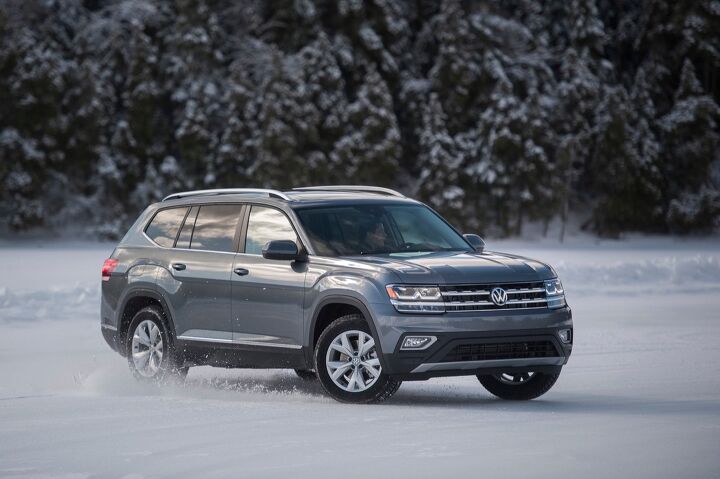Strike Two: UAW Again Fails to Unionize Volkswagen Plant

The results of a Friday vote are in, and Volkswagen can breathe a sigh of relief. Five years after the United Auto Workers first attempted to place the automaker’s Chattanooga, Tennessee assembly plant under its umbrella, a second vote has yielded the same results.
Weeks and months of acrimony, ads, accusations, and other seemingly unavoidable aspects of union organizing led to a narrow win for the no-union side. As before, Southern auto plants remain just beyond the grasp of the UAW.
Volkswagen was seen as a ripe target for the UAW to gain a toehold south of the Ohio River, even after a 2014 vote returned 712 in favor of the status quo and 626 backing UAW representation. This time around the vote was even closer — 833 against UAW, 776 in favor, according to the Chattanooga Times Free Press. Ninety-three percent of eligible workers voted.
Both sides hurled the usual tropes at each other in the run-up to the vote, a decision VW successfully delayed via an appeal to the National Labor Relations Board. Anti-labor forces pointed to the UAW’s Fiat Chrysler corruption scandal, which, unhappily for UAW brass, reinforced a laundry list of stereotypes about well-fed, back-scratching labor execs and their equally greedy corporate partners. Pro-union types pointed to VW’s own history of nefarious deeds, topmost being the recent diesel emissions scandal.
You could search a military bunker and turn up less ammunition.
The vote gives VW a reason not to bargain with a group of Chattanooga maintenance workers who voted to unionize a year after the first failed attempt to unionize the plant. The automaker refuses to bargain with the group, claiming such negotiations should include all workers and maintenance staff, not just a subset of its workforce.
“Clearly Volkswagen was able to delay bargaining with maintenance [workers] and ultimately this vote among all production and maintenance workers through legal games until they could undermine the vote,” said UAW International spokesman Brian Rothenberg.
VW’s Chattanooga plant, home to the Passat and Atlas, employs about 3,500 workers, but will soon see its ranks swell. A number of vehicles could roll out of the Tennessee facility in the coming years; among them, a sportier Atlas-based SUV and two (or more) electric MEB-platform vehicles. In January, VW pledged $800 million towards the plant’s expansion.
Not only would bringing Chattanooga into its fold allow UAW to breach that pesky Southern wall, it would give its own ranks a much-needed boost. The union’s membership has declined drastically since its heyday in the 1970s.
[Image: Volkswagen]

More by Steph Willems
Latest Car Reviews
Read moreLatest Product Reviews
Read moreRecent Comments
- MaintenanceCosts Nobody here seems to acknowledge that there are multiple use cases for cars.Some people spend all their time driving all over the country and need every mile and minute of time savings. ICE cars are better for them right now.Some people only drive locally and fly when they travel. For them, there's probably a range number that works, and they don't really need more. For the uses for which we use our EV, that would be around 150 miles. The other thing about a low range requirement is it can make 120V charging viable. If you don't drive more than an average of about 40 miles/day, you can probably get enough electrons through a wall outlet. We spent over two years charging our Bolt only through 120V, while our house was getting rebuilt, and never had an issue.Those are extremes. There are all sorts of use cases in between, which probably represent the majority of drivers. For some users, what's needed is more range. But I think for most users, what's needed is better charging. Retrofit apartment garages like Tim's with 240V outlets at every spot. Install more L3 chargers in supermarket parking lots and alongside gas stations. Make chargers that work like Tesla Superchargers as ubiquitous as gas stations, and EV charging will not be an issue for most users.
- MaintenanceCosts I don't have an opinion on whether any one plant unionizing is the right answer, but the employees sure need to have the right to organize. Unions or the credible threat of unionization are the only thing, history has proven, that can keep employers honest. Without it, we've seen over and over, the employers have complete power over the workers and feel free to exploit the workers however they see fit. (And don't tell me "oh, the workers can just leave" - in an oligopolistic industry, working conditions quickly converge, and there's not another employer right around the corner.)
- Kjhkjlhkjhkljh kljhjkhjklhkjh [h3]Wake me up when it is a 1989 635Csi with a M88/3[/h3]
- BrandX "I can charge using the 240V outlets, sure, but it’s slow."No it's not. That's what all home chargers use - 240V.
- Jalop1991 does the odometer represent itself in an analog fashion? Will the numbers roll slowly and stop wherever, or do they just blink to the next number like any old boring modern car?































Comments
Join the conversation
Is it even possible for the workers there to join IG Metall instead?
Ugh. It is so dissappointing when political discourse overwhelms the car talk.